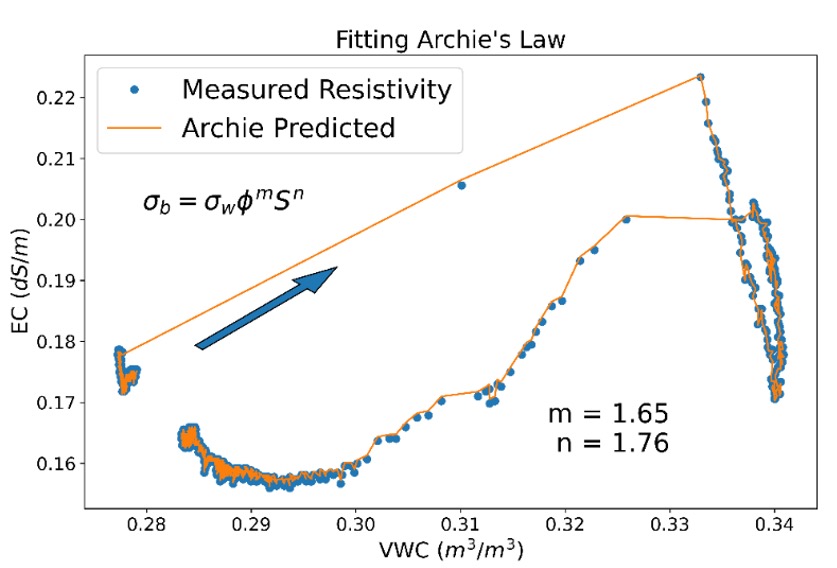My former student and newly minted Ph.D., Dr. Gina Pope, and I recently had a paper accepted in the Journal of Environmental and Engineering Geophysics. We think the paper is important because is shows the necessity of monitoring the pore fluid conductivity when using electrical resistivity to track water infiltration. Applying Archie’s Law assuming the pore fluid conductivity remains constant may yield erroneous saturation estimates. The same resistivity value can correspond to different moisture levels depending on whether the soil is wetting or drying out.

Apparent Hysteresis in Archie’s Law: Implications of Changing Pore Fluid Conductivity for Electrical Resistivity Monitoring of Infiltration
Gina Ginevra Pope and Jonathan E. Nyquist
Abstract
The electrical resistivity of the vadose zone is highly dependent on soil moisture content, making resistivity tomography a potential tool for non-intrusive monitoring of infiltration. There is a long history of using petrophysical relationships such as Archie’s law to convert resistivity values to volumetric water content, often under the assumption that the pore fluid conductivity is constant. Analysis of two years of nearly continuous soil conductivity and moisture data from sensors buried in a bioswale in Philadelphia, Pennsylvania showed that the characteristic curve of volumetric water versus soil resistivity exhibited hysteresis. The same value of electrical resistivity was associated with different degrees of saturation during imbibition and drying. Accurate water content could be estimated using Archie’s law only when changes in pore fluid conductivity were incorporated. In addition to the cyclic changes with each rain event, pore fluid conductivity varied throughout the year, with the highest values recorded during the winter due to road salt runoff, followed by a gradual decline with each rain event. Cementation and saturation exponents differed for sensors within 25 cm of each other despite the uniform nature of the bioswale fill material and despite fits to Archie’s Law for individual sensors, indicating considerable heterogeneity. A pattern of changing pore fluid conductivity in response to storms was confirmed at two additional sites with soil moisture and bulk conductivity sensors. Assuming that the conductivity of the pore fluid remains constant during infiltration not only produces erroneous soil moisture estimates, it can even reverse the apparent soil moisture trend. We conclude that to use electrical resistivity to monitor infiltration it is essential to independently record changes in pore fluid conductivity, and that multiple sensors are required because changes in pore fluid conductivity, as well as Archie parameters, can vary on a sub-meter scale for even apparently homogeneous sites. Additionally, long-term changes in Archie parameters, notably are possible, and may indicate long-term changes in soil fabric.
